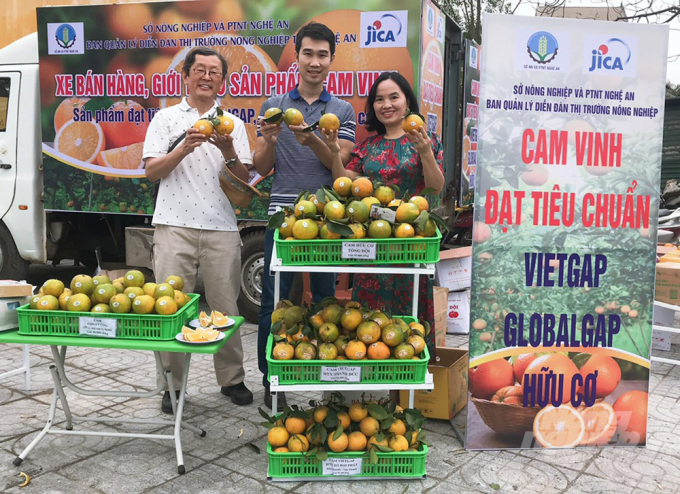May 21, 2025 | 04:23 GMT +7
May 21, 2025 | 04:23 GMT +7
Hotline: 0913.378.918
May 21, 2025 | 04:23 GMT +7
Hotline: 0913.378.918
The Department of Agriculture and Rural Development of Nghe An, in collaboration with the Japan International Cooperation Agency (JICA), hosted a workshop on the Efficient Record Keeping System in agriculture.

Mr. Murooka Naomichi, Deputy Chief Representative of the JICA Office in Vietnam emphasized the importance of record keeping in agriculture. Photo: Viet Khanh.
According to industry analysts, the Vietnamese agriculture sector is poised for rapid growth. Although Vietnam's agricultural GNP in 2018 was just a tenth of Japan's, the country's population of 22 million was 11 times that of Japan. Vietnam has around 12 million hectares of arable land, which is almost three times the size of Japan. Vietnam has tremendous agricultural output potential and capacity for expansion.
Mr. Murooka Naomichi, Deputy Chief Representative of JICA, highlighted the growing demand for food safety in Vietnam, particularly among high-end stores and Japanese exporters. Due to this, we must enhance production scheduling by increasing awareness of the significance of record keeping in agriculture using software and digital technologies.
Good record keeping aids in mitigating costs, limiting labor, and enhancing crop output, all while satisfying the criteria of the many parties involved in the traceability issue.
To take advantage of this opportunity, the Agribusiness Japan Desk (ABJD) was founded with the purpose of boosting investment of Japanese resources in Vietnam and reviving the potential of Vietnamese agriculture with Japanese private sector cooperation.

Deputy Director of Nghe An Department of Agriculture and Rural Development, Ms. Vo Thi Nhung highly appreciated the application of digital technology in production. Photo: Viet Khanh.
ABJD has served as a connector for businesses by finding business partners and consumers. Both Japan and Vietnam have advanced in the direction of mutually beneficial growth due to their strong connections, which have facilitated the activation of agriculture sector firms.
Ms. Vo Thi Nhung, the Deputy Director of the Department of Agriculture and Rural Development, said that the workshop aimed to promote knowledge of the significance of record keeping in agriculture by establishing several goals. Accelerating the application of scientific and technical advancements, particularly digital technology, to manufacturing is required.
Ms. Nhung stated that the Nghe An Department of Agriculture and Rural Development tasked the Agricultural Market Forum Management Board with coordinating with relevant units and localities to continue coordinating, working, and grasping details of activities, conditions, and methods of purchasing agricultural products to promote the consumption of local products in the future.

JICA plays an important role in the agricultural production of Nghe An, especially in the application of safe agricultural processes. Photo: VK.
Nghe An has been implementing three agricultural projects with the assistance of the Japan International Cooperation Agency in Vietnam: A technical cooperation project on planning agricultural development (completed); a Project to restore and upgrade the Northern Irrigation System (ongoing loan project); and Project on restoration and sustainable management of protection forests in Nghe An province (JICA2 project is underway).
Translated by Linh Linh

(VAN) Japan's grant aid project contributes to capacity building, promoting organic agricultural production, and fostering sustainable community development in Dong Thap province.

(VAN) For years, the CRISPR-Cas9 genome technology has been reshaping genetic engineering, a precision tool to transform everything from agriculture to medicine.

(VAN) Vietnam aims to become a 'leader' in the region in the capacity and managing effectively soil health and crop nutrition.
![Reducing emissions from rice fields: [Part 1] Farming clean rice together](https://t.ex-cdn.com/nongnghiepmoitruong.vn/608w/files/news/2025/05/05/z6509661417740_a647202949c539012a959e841c03e1d3-nongnghiep-143611.jpg)
(VAN) Growing clean rice helps reduce environmental pollution while increasing income, allowing farmers to feel secure in production and remain committed to their fields for the long term.
/2025/05/19/5136-1-144800_230.jpg)
(VAN) The Nghe An Provincial People's Committee has just approved the list of beneficiaries eligible for revenue from the Emission Reductions Payment Agreement (ERPA) in the North Central region for the year 2025.

(VAN) 14 out of 35 domesticated elephants in Dak Lak province have had their living conditions improved, with 11 of them currently participating in the non-riding elephant tourism model.

(VAN) Muong Nhe Nature Reserve hopes that being upgraded to a national park will lay the foundation for forest protection efforts to be carried out in a systematic, modern, and sustainable manner.